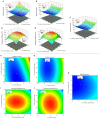Enhanced drug delivery and wound healing potential of berberine-loaded chitosan-alginate nanocomposite gel: characterization and in vivo assessment
- PMID: 38229669
- PMCID: PMC10790630
- DOI: 10.3389/fpubh.2023.1238961
Enhanced drug delivery and wound healing potential of berberine-loaded chitosan-alginate nanocomposite gel: characterization and in vivo assessment
Abstract
Berberine-encapsulated polyelectrolyte nanocomposite (BR-PolyET-NC) gel was developed as a long-acting improved wound healing therapy. BR-PolyET-NC was developed using an ionic gelation/complexation method and thereafter loaded into Carbopol gel. Formulation was optimized using Design-Expert® software implementing a three-level, three-factor Box Behnken design (BBD). The concentrations of polymers, namely, chitosan and alginate, and calcium chloride were investigated based on particle size and %EE. Moreover, formulation characterized in vitro for biopharmaceutical performances and their wound healing potency was evaluated in vivo in adult BALB/c mice. The particle distribution analysis showed a nanocomposite size of 71 ± 3.5 nm, polydispersity index (PDI) of 0.45, ζ-potential of +22 mV, BR entrapment of 91 ± 1.6%, and loading efficiency of 12.5 ± 0.91%. Percentage drug release was recorded as 89.50 ± 6.9% with pH 6.8, thereby simulating the wound microenvironment. The in vitro investigation of the nanocomposite gel revealed uniform consistency, well spreadability, and extrudability, which are ideal for topical wound use. The analytical estimation executed using FT-IR, DSC, and X-ray diffraction (XRD) indicated successful formulation with no drug excipients and without the amorphous state. The colony count of microbes was greatly reduced in the BR-PolyET-NC treated group on the 15th day from up to 6 CFU compared to 20 CFU observed in the BR gel treated group. The numbers of monocytes and lymphocytes counts were significantly reduced following healing progression, which reached to a peak level and vanished on the 15th day. The observed experimental characterization and in vivo study indicated the effectiveness of the developed BR-PolyET-NC gel toward wound closure and healing process, and it was found that >99% of the wound closed by 15th day, stimulated via various anti-inflammatory and angiogenic factors.
Keywords: alginate; berberine; chitosan; nanocomposite; nanomedicine; nanotechnology; polymer; wound healing.
Copyright © 2023 Akhter, Al-Keridis, Saeed, Khalilullah, Rab, Aljadaan, Rahman, Jaremko, Emwas, Ahmad, Alam, Ali, Khan and Afzal.
Conflict of interest statement
The authors declare that the research was conducted in the absence of any commercial or financial relationships that could be construed as a potential conflict of interest.
Figures







Similar articles
-
Formulation and optimization of surfactant-modified chitosan nanoparticles loaded with cefdinir for novel topical drug delivery: Elevating wound healing efficacy with enhanced antibacterial properties.Int J Pharm. 2024 Dec 5;666:124763. doi: 10.1016/j.ijpharm.2024.124763. Epub 2024 Sep 25. Int J Pharm. 2024. PMID: 39332464
-
Fabrication of moxifloxacin HCl-loaded biodegradable chitosan nanoparticles for potential antibacterial and accelerated cutaneous wound healing efficacy.J Microencapsul. 2022 Jan;39(1):37-48. doi: 10.1080/02652048.2021.2019332. Epub 2021 Dec 24. J Microencapsul. 2022. PMID: 34919007
-
Berberine Encapsulated Lecithin-Chitosan Nanoparticles as Innovative Wound Healing Agent in Type II Diabetes.Pharmaceutics. 2021 Aug 4;13(8):1197. doi: 10.3390/pharmaceutics13081197. Pharmaceutics. 2021. PMID: 34452159 Free PMC article.
-
Augmented healing of full thickness chronic excision wound by rosmarinic acid loaded chitosan encapsulated graphene nanopockets.Drug Dev Ind Pharm. 2020 Jun;46(6):878-888. doi: 10.1080/03639045.2020.1762200. Epub 2020 May 13. Drug Dev Ind Pharm. 2020. PMID: 32338544
-
Development of Natural Polysaccharide-Based Nanoparticles of Berberine to Enhance Oral Bioavailability: Formulation, Optimization, Ex Vivo, and In Vivo Assessment.Polymers (Basel). 2021 Nov 5;13(21):3833. doi: 10.3390/polym13213833. Polymers (Basel). 2021. PMID: 34771389 Free PMC article.
Cited by
-
Research progress on pharmacological effects and bioavailability of berberine.Naunyn Schmiedebergs Arch Pharmacol. 2024 Nov;397(11):8485-8514. doi: 10.1007/s00210-024-03199-0. Epub 2024 Jun 18. Naunyn Schmiedebergs Arch Pharmacol. 2024. PMID: 38888754 Review.
-
Chitosan/Sodium Alginate Hydrogel for the Release of Berberine as an Algae Suppressant: RSM Optimization and Analysis of Sustained Release Characteristics.Gels. 2024 Sep 13;10(9):591. doi: 10.3390/gels10090591. Gels. 2024. PMID: 39330193 Free PMC article.
-
Exploring the role of virtual reality in preparing emergency responders for mass casualty incidents.Isr J Health Policy Res. 2025 Apr 9;14(1):22. doi: 10.1186/s13584-025-00681-9. Isr J Health Policy Res. 2025. PMID: 40205512 Free PMC article.
-
The Role of Nanoparticles in Accelerating Tissue Recovery and Inflammation Control in Physiotherapy Practices.Cureus. 2024 Nov 12;16(11):e73540. doi: 10.7759/cureus.73540. eCollection 2024 Nov. Cureus. 2024. PMID: 39669817 Free PMC article. Review.
-
Natural Products for Improving Soft Tissue Healing: Mechanisms, Innovations, and Clinical Potential.Pharmaceutics. 2025 Jun 8;17(6):758. doi: 10.3390/pharmaceutics17060758. Pharmaceutics. 2025. PMID: 40574070 Free PMC article. Review.
References
-
- Schultz GS, Chin GA, Moldawer L, Diegelmann RF. Principles of wound healing In: Fitridge R, Thompson M, editors. Mechanisms of vascular disease: A reference book for vascular specialists. Adelaide, AU: University of Adelaide Press; (2011)
Publication types
MeSH terms
Substances
LinkOut - more resources
Full Text Sources

